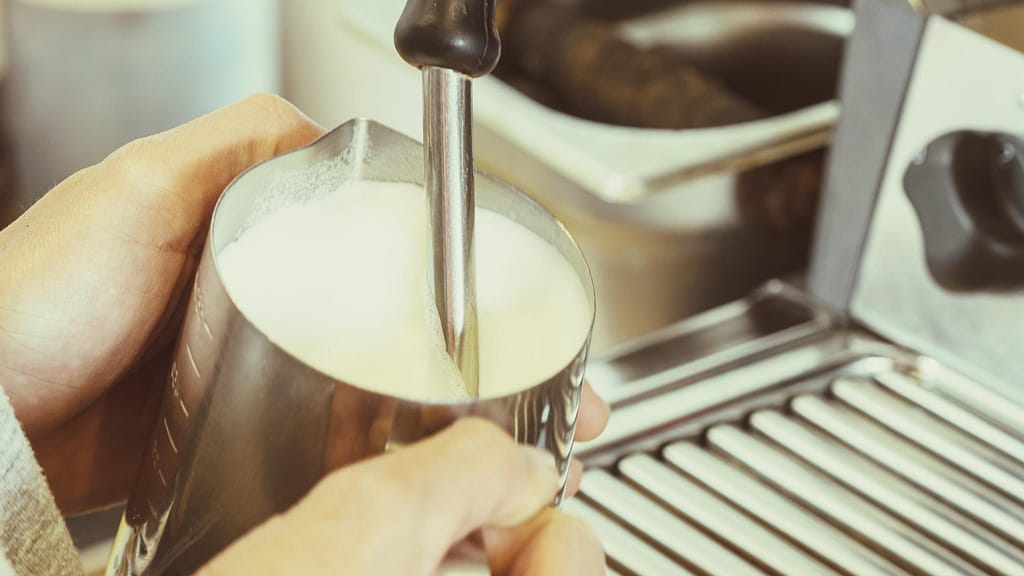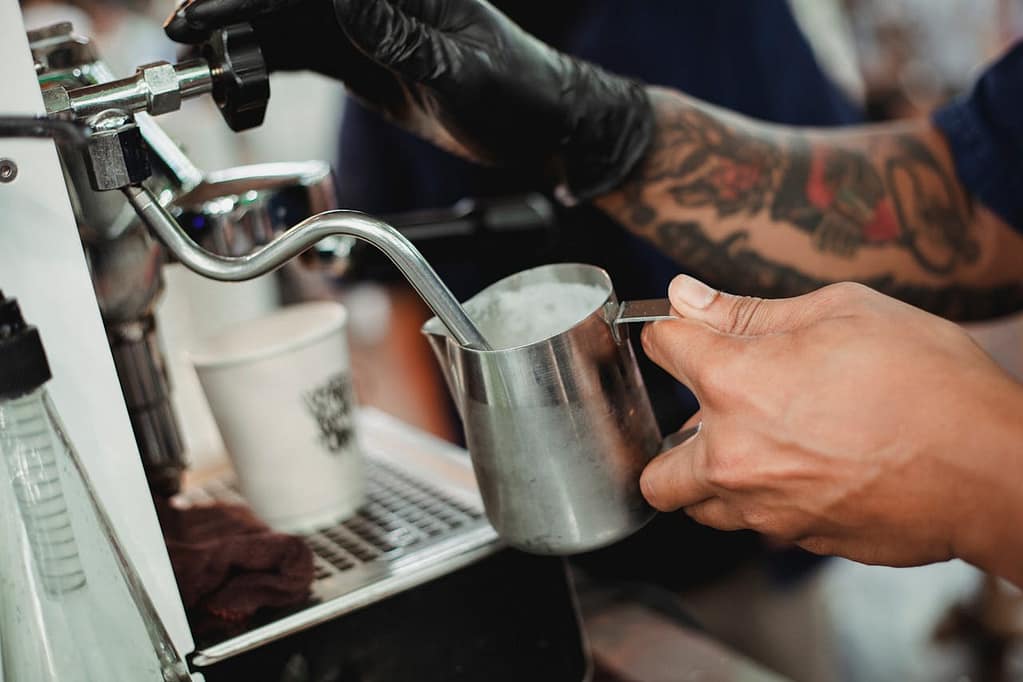Ever wondered why your homemade lattes don’t measure up to those fancy ones from your favorite café? The key is in mastering milk frothing. This skill turns regular coffee into a smooth, tasty drink. We’ll cover everything from choosing the right gear to perfecting your steaming method. This guide will help you improve your latte skills and wow your friends with amazing latte art.
Milk frothing is not just about making bubbles. It’s about creating the perfect microfoam that mixes well with espresso. By learning the details of milk steaming, you can make that silky texture that’s key for taste and looks. These tips are great for both new baristas and coffee lovers, helping you achieve latte perfection.
Key Takeaways
- Aim for a milk temperature of 150°F (65°C) for optimal frothing results
- Use a 600ml pitcher for ample frothing space
- Position the steam wand at a 45-degree angle for best results
- Fill the pitcher to just below the spout for the right amount of milk
- Choose whole milk for creamier, more stable foam
- Start with cold milk to allow proper aeration time
- Avoid overheating to prevent scalding and maintain foam quality
The Art of Milk Frothing: An Introduction

Milk frothing is key to making tasty lattes and cappuccinos. It’s about adding tiny air bubbles to milk for a creamy texture that goes well with espresso. Learning this skill can take your coffee art and flavors to new heights.
Temperature control is crucial in frothing milk:
- Full cream, skim, and light milk: Heat to 65°C (149°F)
- Alternative milks (almond, soy, coconut): Froth at 55°C (131°F)
Getting the right micro-foam takes practice and care. Baristas try to create a vortex while frothing to stretch the milk evenly. This method makes a silky texture that boosts the coffee’s taste.
Whole milk is often chosen for its high fat content, making a creamy foam. But, skilled baristas can also use plant-based milks for latte art and to meet different customer tastes.
Essential Equipment for Milk Frothing
Learning about the tools of the trade is key in barista training. To get that creamy, velvety texture in your drinks, you need the right gear. Let’s check out the must-have tools for frothing milk to perfection.
Steam Wands and Espresso Machines
Handheld Milk Frothers
For those at home, handheld frothers like the NanoFoamer are a great choice. They mix air into the milk, creating a whirlpool effect. They might not be as good as a steam wand, but they’re perfect for beginners.
Milk Pitchers and Thermometers
A 600ml Rhino jug is essential for frothing milk right. It helps with efficient milk movement. Use a digital thermometer to keep the milk at the perfect temperature without burning it.
- Use cold milk for best results
- Clean your frother regularly
- Avoid over-frothing to prevent large bubbles
Choosing the Right Milk for Frothing
Choosing the right milk is key for making velvety milk foam and cafe-quality froth. Whole milk is the top pick for frothing. It has the right mix of fats, proteins, and sugars for a rich, creamy texture perfect for lattes and cappuccinos.
If you want something lighter, skim milk makes delicate bubbles that are easy to shape. Semi-skimmed milk is a good middle choice, keeping some cream flavor but with less fat. This lets you adjust your frothy coffee to your taste and diet.
Non-dairy options are also popular for frothing:
- Oat milk: Closest to whole milk in texture, creating smooth foam
- Soy milk: Produces stable foam, great for latte art
- Almond milk: Offers a light, nutty flavor with thick foam
Fresh, cold milk works best for frothing. Interestingly, shelf-stable milk often beats fresh milk because it has more protein. When using an automatic frother, keep the milk at a temperature between 70-80°C for the best froth.
Mastering Milk Frothing: Step-by-Step Guide

Perfectly frothed milk is key for tasty lattes and cappuccinos. This guide gives you the best tips for frothing milk at home. You’ll learn how to get results like a pro.
Purging the Steam Wand
Begin by cleaning the steam wand to get rid of any moisture. This makes sure the steam is clean for frothing. It also stops water from mixing with your milk.
Proper Milk Temperature
Fill your pitcher to just below the spout. Cold milk makes froth thicker and creamier. Try to heat it to 65°C (149°F). Check the temperature by touching the pitcher’s side. It should be warm but not too hot.
Creating the Perfect Vortex
Put the steam wand at a 45-degree angle in the pitcher. Place it a bit off-center. This makes a whirlpool that breaks down bubbles and heats the milk evenly. The milk should get twice as full during frothing, making it thick and foamy.
Incorporating Air for Microfoam
To make microfoam:1. Lower the pitcher a bit to add air2. Wait for a soft hissing sound3. Put the pitcher back up to heat more4. Stop the steam when it’s hot enough5. Gently tap the pitcher to get rid of big bubbles
With practice, these tips will make your milk froth perfectly every time. Your home coffee will taste amazing.
Understanding Microfoam and Its Importance
Microfoam is what takes your latte from just okay to amazing. It’s made of tiny, uniform bubbles that make the milk smooth. When done correctly, microfoam looks shiny and flows smoothly.
The micro-foam texture is key for both taste and looks. It mixes well with espresso, making the coffee taste better. For those who make latte art, this foam is their tool. It lets them create detailed designs that turn a simple drink into a masterpiece.
Creating perfect microfoam takes practice and focus. Here are some important tips:
- Milk type: Whole milk makes rich, creamy microfoam. Skim milk gives a big but less creamy foam.
- Temperature: Use cold milk to start. Aim for 150-155°F (65-68°C) when steaming.
- Freshness: Fresh milk makes stable foam. Old milk might not keep air bubbles well.
- Equipment: You need a steam wand or handheld frother for microfoam.
Getting good at microfoam takes time. Begin with cold milk and put your steam wand just below the surface. With practice, you’ll learn the right way to do it. Soon, you’ll make lattes with velvety milk foam that will wow coffee fans.
Common Milk Frothing Mistakes to Avoid
Learning how to steam milk right is key for barista training. It’s important for creating beautiful latte art. Let’s look at some common mistakes and how to avoid them.
Overheating the Milk
One big mistake is heating the milk too much. It should be between 130-150°F for frothing. If it gets hotter than 160°F, it can spoil the taste and feel of your latte. Always use a thermometer to check the temperature while steaming.
Introducing Too Much Air
Getting the right foam means balancing air and milk. Start adding air when the milk is still cold, around 100°F. Try to increase the milk’s volume by about 1/3. Too much air makes big bubbles instead of smooth foam.
Inconsistent Technique
Putting the steam wand in the right spot is crucial. Place it halfway between the center and the wall of the pitcher. This creates a whirlpool, which is key for smooth foam.
- Keep your hand steady and the wand at a consistent angle.
- Make sure the milk moves in circles.
- Don’t let the wand touch the pitcher’s wall.
Remember, different milks need different amounts of air. Milks with more fat need more air. With practice and paying attention to these tips, you’ll get better at frothing milk.
Advanced Techniques for Latte Art

To master latte art, you need practice and precision. Baristas steam more milk than needed for better foam. The ideal milk expansion for latte art is 20-35% after frothing.
When pouring, tilt the cup at a 30-45° angle and start from 7-8cm above. This method helps get designs in the middle. Pour above the cup’s center, keeping the spout no more than halfway in. Changing how fast you pour can change the design.
- Wiggling
- Cutting
- Stacking
- Pushing
These techniques are key for different latte art designs. You can make hearts, rosettas, tulips, and swans. Some baristas use a second pitcher for mixing microfoam, which is important for detailed designs.
For clean latte art, remove most milk before drawing, leaving a few foam drops. The milk should be between 150-155°F for the best quality. Beginners should use a 350-500ml milk pitcher to practice.
Remember, practice is crucial to get better at latte art. With time, you can make stunning, cafe-quality milk froth designs.
Troubleshooting Milk Frothing Issues
Mastering milk frothing tips can be tough. Even pros face challenges when trying for perfectly frothed milk. Let’s look at common problems and how to fix them to improve your latte skills.
Milk Not Frothing Properly
If your milk isn’t frothing, check these things:
- Milk temperature: Aim for 150-160°F for lattes
- Steam wand position: Adjust for optimal vortex
- Milk quality: Fresh, high-quality milk froths better
Inconsistent Foam Quality
Getting consistent microfoam takes practice. Here are some tips for better frothing:
- Use the right amount of milk: 250 ml in a 600 ml jug for full-fat cow’s milk
- Incorporate air gradually: Start with the wand near the surface, then submerge
- Maintain proper temperature: Stop at 158-162°F for cappuccinos
Difficulty Creating Latte Art
Having trouble with latte art? Try these tips:
- Ensure proper milk texture: Silky, paint-like consistency is ideal
- Perfect your pour: Start high, then lower the pitcher close to the cup
- Practice simple designs: Master the tulip pattern before moving to complex art
Creating perfectly frothed milk takes time and patience. Try different milks, jugs, and machines to find what works best for you. With regular practice, you’ll soon be making lattes that look great on Instagram.
Alternative Methods for Milk Frothing
You don’t need a fancy espresso machine for milk frothing. Handheld milk frothers are a great, affordable way to make microfoam at home. These small devices mix air into milk, making a texture like professional steamers.
If you like doing things by hand, a French press can also froth milk. Heat the milk, put it in the press, and move the plunger up and down to froth it. Whole milk, with its 3.5% fat, works best and stays frothy above 113°F.
Using an immersion blender is another option. Heat your milk in a big container, then blend it until it’s frothy. This method might give bigger bubbles than professional steamers, but it still makes a light, airy froth.
- Handheld frothers: Quick and easy for small quantities
- French press: Dual-purpose tool for coffee and frothing
- Immersion blender: Creates voluminous foam
The fat in your milk changes how well it froths. Whole milk makes the best microfoam, while skim milk makes froth that stays stable below 113°F. Try different milks and temperatures to get the froth you like best.
Conclusion
Mastering milk frothing is key to making top-notch lattes and cappuccinos at home. With the right tools, skills, and practice, anyone can get cafe-quality drinks. It’s all about knowing how to make microfoam and keeping the milk at 60-65°C (140-149°F).
A 600ml stainless steel milk jug is great for home use. It’s durable and keeps the milk tasting fresh. Beginners should start with full-fat milk, as it froths better for latte art. Use full steam power and try a toothpick to adjust the steam pressure for the right froth.
Steer clear of overheating the milk and adding too much air to avoid common mistakes. Focus on creating a perfect vortex to improve your frothing skills. With hard work and careful attention, you can master milk frothing. This will help you create beautiful latte art and smooth, tasty drinks that compare to those in fancy cafes.










